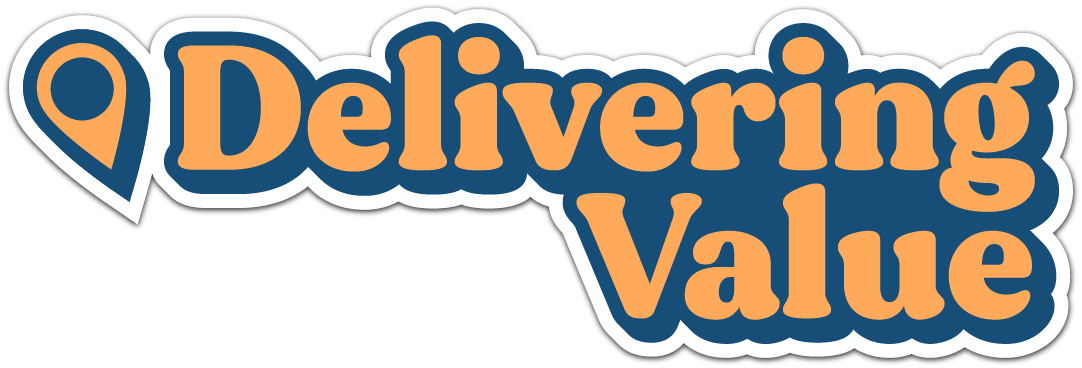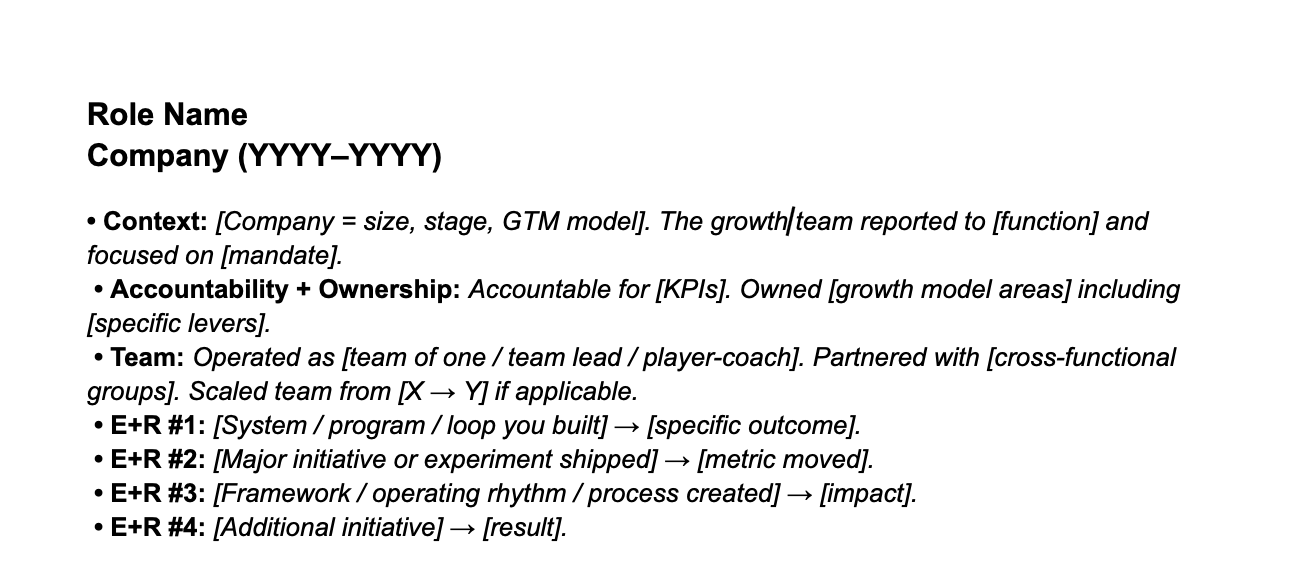How to Write Your Head of Growth Resume (examples + sample template)
If you’re looking for a sample Head of Growth resume - or a framework you can apply to yours, this guide shows you exactly how to write a growth-leadership resume that stands out in a crowded hiring market.
Most growth resumes share the same problem.
Over the past year, I have watched talented growth leaders apply to roles they were clearly qualified for and still get ignored. These are people who led meaningful initiatives, drove real results, and were respected by their peers. Yet they kept getting ghosted. They were doing everything they were told to do. They were listing big metrics. They were stacking accomplishments. They were following the traditional playbook. And the market still felt closed off.
It is tempting to blame the competition or the economy. It is even easier to blame yourself.
But in most cases, the real issue is that your resume is not helping people understand you.
Head of Growth Resume Example
Download head of growth resume template
Why the Old Resume Advice Doesn’t Work Anymore
For years, the standard guidance was simple. List your highlights. Mention the percentage lift. Lead with the biggest numbers. That used to work because a human being read every resume. It worked because someone with context looked at your story and understood your role in it.
That world is gone.
Today, the first pass is almost always done by software. The tool scanning your resume does not understand nuance. It does not understand the difference between a growth PM and a lifecycle marketer. It does not understand the realities of a sales led environment versus a PLG environment. It is matching patterns. It is looking for structure. It is not evaluating your impact. If the information is not organized in a way the system can read, your story gets filtered out before anyone sees it.
This is why your metrics alone are not carrying you anymore.
The Hidden Problem Inside Most Growth Resumes
The biggest issue I see is not weak experience or lack of some technical skills. It is missing context and narrative.
Here’s what I mean…
Growth roles look different across companies. A growth marketer inside a PLG SaaS company plays a different game than a growth PM supporting an enterprise inside sales motion. A Head of Growth at a 40 person startup has a completely different set of responsibilities than a Head of Growth at a 2,000 person scale up. The same title can mean five different things depending on stage, team structure, traffic volume, and GTM model.
You understand those distinctions because you have lived them. The recruiter or hiring manager reading your resume probably has not. Many have never done your role. Many assume “growth” means something entirely different. And when they look at your resume without context, they are forced to guess. When they guess wrong, you get skipped.
That is why strong candidates keep getting overlooked.
How to Structure Your Head of Growth Resume
After working with dozens of growth leaders on their job searches, I started testing a different way to structure their resumes. I wanted something that made sense to humans and also played nicely with AI screening tools. I wanted a way to help reviewers understand the full picture without making them work to connect the dots. And I wanted something simple enough that you could apply it in under an hour.
What emerged from that experimentation became the CATER framework.
CATER is a structured way to tell your story so that someone scanning your resume understands the game you were playing, the levers you owned, the team around you, and the results you drove. It puts everything in the right order. It reduces guesswork. It makes your experience easier to match.
Here is what each part means in practice.
How the CATER Framework Actually Works
C is Context. This is where you set the scene. In one line, you explain the size of the company, the stage of the business, the GTM model, and where your role sits in the organization. A growth role at a PLG startup is not the same as a growth role inside an enterprise environment. A job in a high volume, fast-feedback business is not the same as a job in a slower, relationship-driven one. When you spell this out, the reader finally understands the environment you operated in and the difficulty level of your work.
A is Accountability and Ownership. Accountability is the small set of KPIs you were judged on. Ownership is the part of the growth model you directly controlled. Together, these explain the scoreboard you played on and the levers you had available. Once people understand this, your results make sense.
T is Team. Every growth role changes depending on the team behind you. If you were a team of one, people can assume you were deep in the work. If you led a small pod, they can assume you were a player coach. If you managed a larger function, they can assume your job centered around hiring, alignment, and influence. One bullet here clears up all that interpretation.
E and R are Execution and Results. This is where you show what you built and what happened. The structure is simple. System you owned, followed by the specific outcome it produced. These bullets are short, clear, and tied directly to the earlier context. And because you have already explained your environment and your ownership, the reader can finally understand the meaning of the results.
This order mirrors how strong hiring managers think.
What This Looks Like in Real Life
One of my clients, Nick, saw this firsthand. He was Director of Growth at a large B2B SaaS company and wanted a VP level role. His resume looked strong on paper. He had the wins. He had the metrics. He had the title. But he kept getting funneled into roles that did not match what he actually wanted to do. Some were too narrow. Others sat in the wrong part of the funnel. Many were not even close.
When we sat down and looked at his resume, the issue became obvious. His story was incomplete. His experience was strong, but the context was missing. He looked like every other “growth person” with good numbers. No one understood the environment he was in or the scope of his ownership.
We rewrote the entire thing using CATER.
He also used the same structure on his LinkedIn profile and in his interview stories.
A couple of months later, he landed a VP of Growth role at a product led company that actually aligned with what he wanted.
That clarity changed everything.
What To Do Next
If you want to apply this for yourself, start with your most recent role. Open a blank doc. Then write one bullet for each CATER section. Keep the language simple. Anchor everything in the reality of your environment. Then add three or four clean execution and result bullets underneath. Your goal is not to include every detail. Your goal is to make your story easy to understand.
To make this even easier, I created a resume template that follows the entire CATER structure. It includes space for each section plus examples for different types of growth roles. You can download it and use it as your starting point so you are not staring at a blank page.
Because the best growth resumes in 2026 are not about looking impressive. They are about helping someone understand you.

